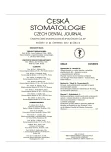A Contemplation about the Importance of Prosthetic Defect Classification Systems in Contemporary Dentistry
Authors:
Z. Zdráhal; J. Krňoulová; R. Slezák
Authors‘ workplace:
Stomatologická klinika LF UK a FN, Hradec Králové
Published in:
Česká stomatologie / Praktické zubní lékařství, ročník 112, 2012, 4, s. 79-85
Category:
Review Article
Overview
Introduction:
The aim of the dental care is ensuring the biological and social functions of dentition throughout all the life of an individual. Planning prosthetic reconstruction is based on the analysis of all available data (e. g., history, clinical findings, imaging techniques, etc.). There are several classifications of the dental arch defects which determine the type of the defect. Some deal with the placement of the remainig teeth and gaps, others with shortened dental arches and gaps, presence of so-caled supporting zones or teeth having regard to the transfer of the chewing pressure.
Objectives:
The authors describe the seven best-known classification systems according to Voldřich, Kennedy, Wild, Eichner, Witter, Körber, and Tvrdoň. They describe the distribution of prosthetic teeth defects to certain groups or classes in terms of conventional and implantology prosthetic dentistry. They present the most common treatment options prosthetic defects – frontal gap, unilaterally or bilaterally shortened dental arch, loss of half of the dental arch, toothless jaw, the first two prosthetic defects are divided into subgroups, differing number of teeth lost. They recapitulate the current possibilities of reconstruction of the above defects using implantology and conventional prosthetic dentistry. The authors discuss this issue in the context of current possibilities of prosthetic treatment modes and try to answer the question, if this knowledge still remains useful and reveals practical use.
Key words:
prosthetic dentistry – classifications of dental defects – supporting zones – shortened dental arch – dental implantology – conventional and alternative prosthetic treatment
Sources
1. Bartáková, S., Prachár, P., Vaněk, J.: Klasifikace defektů chrupu I. StomaTeam, 2008, č. 2, s. 15–18.
2. Bartáková, S., Prachár, P., Vaněk, J.: Klasifikace defektů chrupu II. StomaTeam, 2008, č. 3, s. 14–19.
3. Dostálová, T.: Fixní a snímatelná protetika. Praha, Grada Publishing, 2004, s. 12–18.
4. Krňoulová, J, Hubálková, H.: Fixní zubní náhrady. Praha, Quintessenz, 2002, s. 24–29.
5. Marxkors, R.: Lehrbuch der zahnärztlichen Prothetik, 3. vyd. Köln, München, Deutsche Zahnärzte Verlag DÄV-Hanser, 2000, s. 230 až 262.
6. Strub, J. R., Türp, J. C., Witkovski, S., Hürzeler, M. B., Kern, M.: Curriculum Prothetik, Band III. Berlin, Quintessenz Verlags-GmbH, 1994, s. 865–872.
7. Šimůnek, A., a kol.: Dentální implantologie, 2. vyd. Hradec Králové, Nucleus, 2001, s. 43–52.
8. Tvrdoň, M., a kol.: Protetická stomatológia, Bratislava, Science, 1999, s. 77–89.
9. Vacek, M., Bittner, J. Gnatologie. Praha, Avicenum, 1986, s. 175.
10. Voldřich, M., Mareš, J., Černý, K., Rus, R. Učebnice stomatologické protetiky, 1. vyd. Praha, Státní zdravotnické nakladatelství, 1955, s. 244–249.
Labels
Maxillofacial surgery Orthodontics Dental medicineArticle was published in
Czech Dental Journal

2012 Issue 4
- What Effect Can Be Expected from Limosilactobacillus reuteri in Mucositis and Peri-Implantitis?
- The Importance of Limosilactobacillus reuteri in Administration to Diabetics with Gingivitis
Most read in this issue
- A Contemplation about the Importance of Prosthetic Defect Classification Systems in Contemporary Dentistry
- Analysis of Deciduous and Permanent Teeth of Children from Brno of 1–15 years of Age with the Focus on Frequency of Dental Caries and Teeth Eruption
- Bond Strength of Adhesive Materials for Bonding of Orthodontic Brackets
- Fluoride Content in the Nutrition of Infants and Younger Preschool Children – Instant Baby Food Products
